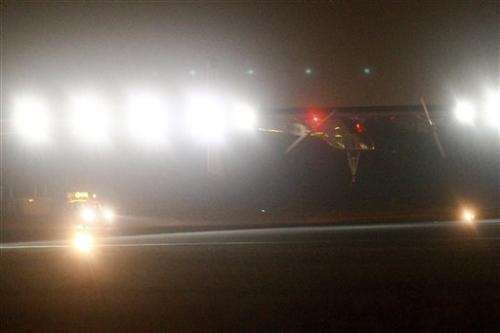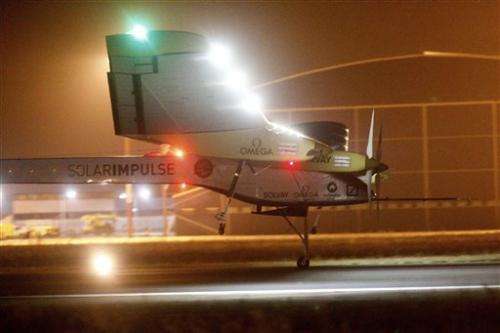Morocco promotes solar energy with plane landing

(AP) -- Morocco's ambitious and expensive plan to draw 40 percent of its energy needs from the limitless power of its blazing sun by 2020 received a publicity boost this week as the first solar powered plane to make an intercontinental flight landed in the North African kingdom.
As Swiss pilot and adventurer Bertrand Piccard stepped out of the fragile craft in front of reporters late Tuesday following his 20-hour flight from Madrid, he immediately paid tribute to Morocco's solar ambitions, which include one day exporting electricity to Europe.
"We came here out of admiration for Morocco's pioneering solar energy program," Piccard said, flashing a brilliant smile and hugging members of his team on the tarmac.
Just moments earlier, the Solar Impulse had swept silently out of the darkness to glide onto the runway. Its four battery-powered turbo-props were already still, showing off the aircraft's ability to fly even when the sun is gone.
"It was perhaps the most beautiful flight of my life. I have dreamed since I was a child of flying without using fuel," said Piccard, who hails from a family of adventurers and who already has circumnavigated the world by balloon.
The plane's 1,554 mile (2,500 kilometer) trip from Switzerland to Morocco was closely followed around Europe and Piccard's fellow pilot and Solar Impulse partner, Andre Borschberg, said it was an important symbol about what could be done without fossil fuels.
"It shows solar energy is a technology that we can trust," he said at the airport before heading off in a helicopter to escort in his airborne colleague.
In 2009, Morocco announced a $9 billion project to build five solar energy plants to harness the sun's rays and produce 2,000 megawatts of electricity by 2020.
The newly created Moroccan Agency for Solar Energy, known as Masen, sponsored the arrival of the Solar Impulse.
The lavish ceremony showcased the kingdom's own solar ambitions and its plans to soon announce which international consortium has won the bid to start work on a 160-megawatt solar power plant to be built in the southern city of Ouarzazate.
"With solar energy you can do many things, you can fly a plane from Payerne, Switzerland to Rabat, you can use solar energy for daily activities — it's no longer just in the realm of science," said Mustafa Bakkouri, the head of Masen, shortly before the Solar Impulse landed.
"We have to reduce our dependence on fossil fuels, most of which we import," he added.
Morocco is one of the few countries in the region almost wholly dependent on imports for its energy needs, and it has been hard hit by the soaring oil prices over the last few years.

As if to underscore the importance of its new commitment to solar energy, the government was forced to reduce subsidies Saturday on gasoline and diesel, raising the price at the pump by 20 and 15 percent respectively.
"The decision was taken to preserve the macro-economic balance," argued Budget Minister Idriss Azami in a Monday interview published in the Le Matin daily. Already 80 percent of the subsidy budget has been used and the year is only half over.
The increase in fuel prices is expected to also push up the price of food, much of which is trucked in from farms in the deep south and elsewhere. In Rabat's low income Akkari neighborhood, food vendors tensed for the inevitable spike.
"Zucchini and carrots have already gone up 20 percent. I hope they stay there because they are already too expensive," said vegetable seller Mohammed Yahyaoui.
As she browsing through the artfully constructed pyramids of vegetables nearby, housewife Fatiha Ait Si swore her family couldn't handle any more price increases. "We are at our end," she said.
There are fears that rising prices could provoke demonstrations that have largely subsided since last year.
It will be a while before Morocco's solar energy comes online. The Ouarzazate plant is expected to be operational by 2014, with plans to boost its capacity to 500 megawatts by 2015.
Meanwhile, Morocco is finding that solar energy does not come cheap.

The Ouarzazate plant was originally set to cost $440 million, but has since ballooned to at least $1.25 billion. Funding comes from an array of international sources, including the World Bank, the African Development Bank and a consortium of German companies promoting solar energy across North Africa called Dii.
International development funds have been earmarked for similar projects in Algeria, Tunisia, Egypt and Jordan, but none are nearly as advanced as in Morocco, where the 2,500 hectare (10 square mile) Ouarzazate site has been marked out on the edge of the desert.
Morocco's plants will be using concentrated solar power, a different technology than the 12,000 photovoltaic cells lining the jumbo jet sized wings of the Solar Impulse.
In the Morocco facilities, endless rows of parabolic mirrors will heat up a synthetic oil, which will then produce steam to turn turbines to produce the electricity.
Like the Solar Impulse, which can fly only in perfect weather conditions and has a cruising speed of around 40 miles per hour (64 kilometers per hour), solar power has yet to be perfected as a technology that could replace fossil fuels.
The power from the Ouarzazate plant is expected to cost twice as much as fossil energy, a difference the Moroccan government has pledged to cover before selling it to the state electricity company — for now with the help of a World Bank loan.
"A further set of loans will be needed to subsidize the electricity produced," noted a cautioning report on the project by the U.K.-based World Development Movement, which campaigns against world poverty. "The electricity produced will be too expensive for domestic consumers."
One set of consumers that is expected to welcome this new source of energy, regardless of the price, is in Europe, where many countries have measures in place to requiring an increased reliance on renewable energy sources. They are expected to be willing to pay a premium for Morocco's clean solar energy.
The Dii consortium envisages a string of solar energy plants across North Africa that would eventually supply all the energy needs there, as well as 15 percent of Europe's.
Piccard said the importance of his flight was not to offer an alternative to commercial airliners but to push the limits of what is believed possible with solar technology.
"Solar Impulse shows that new technology can do what was once thought to be impossible," Piccard said. "People probably once told Masen it was impossible to develop solar energy on that scale."
Copyright 2012 The Associated Press. All rights reserved. This material may not be published, broadcast, rewritten or redistributed.





















